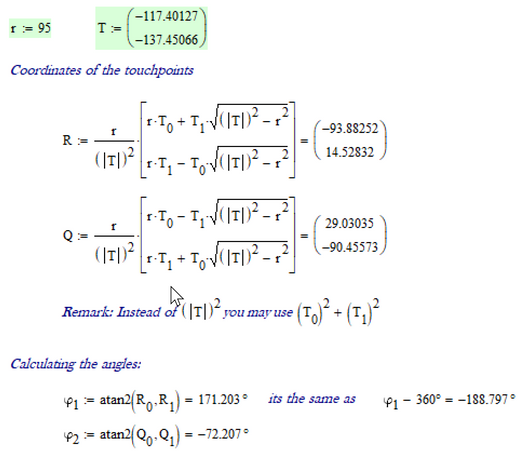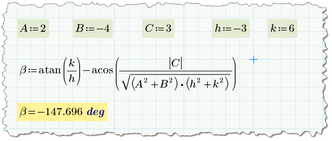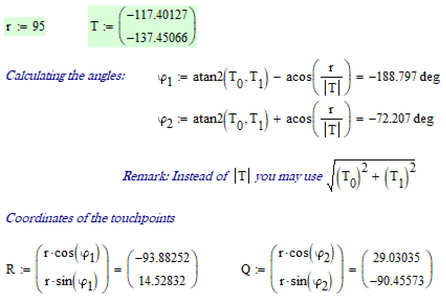Community Tip - You can subscribe to a forum, label or individual post and receive email notifications when someone posts a new topic or reply. Learn more! X
- Subscribe to RSS Feed
- Mark Topic as New
- Mark Topic as Read
- Float this Topic for Current User
- Bookmark
- Subscribe
- Mute
- Printer Friendly Page
Use case enquiry
- Mark as New
- Bookmark
- Subscribe
- Mute
- Subscribe to RSS Feed
- Permalink
- Notify Moderator
Use case enquiry
Good day
Any advice on the following use case would be appreciated.
I'm designing 2 non round variable pitch cams.
Most of the calculations I've done in Excel but have gotten stuck on finding the angle of rotation of the second cam so that a vector of the cam passes through a point.
I can do a Matrix translation and rotation on the vector but need to find that angle.
There is a measured geometrical solution in CAD that works, but it takes very long to make changes so would like another solution.
Math can be found here, above my pay grade, but I though Mathcad might be easier.
Express if possible, I do not have Mathcad, but this is a once-off so can do trial if required.
Thanks
Trenton
Solved! Go to Solution.
- Labels:
-
Algebra_Geometry
Accepted Solutions
- Mark as New
- Bookmark
- Subscribe
- Mute
- Subscribe to RSS Feed
- Permalink
- Notify Moderator
From your last post it looks like you are finally interested in the coordinates of the points Q and R, not necessarily in the angles.
You could calculate the coordinated directly like this and of course you could use the point coordinates to calculate the angles:
Again those calculations could be done in Excel as well.
- Mark as New
- Bookmark
- Subscribe
- Mute
- Subscribe to RSS Feed
- Permalink
- Notify Moderator
So the input values are A,B,C, h and k and the value you are looking for is the angle beta (one of the two solutions possible) as given in the in the first answer of the stackexchange thread you point to?
Sure it would be easy to do in Mathcad or Prime,
but it should be as easy to do in Excel. Excel offers ARCCOS() or ACOS(), ARCTAN() or ATAN() and the square root SQRT. What else would you need more?
If you are looking for a free calculation program you may want to explore GeoGebra (Classic 6 or 5) -> https://www.geogebra.org/download
BTW, I also wonder if A,B and C really are the most natural input values for your real world problem.
I also wonder if the formula given in the stackexchange thread is fully correct. It sure misses the absolute value of C and it only returns one value while the task has two solutions.
- Mark as New
- Bookmark
- Subscribe
- Mute
- Subscribe to RSS Feed
- Permalink
- Notify Moderator
Oh, I think I see it now, (3) is the solution for the angle. I thought I had to sub (3) into (1) but that is for the line that I don't really need.
I don't need to use A,B or C as I have R as another vector perpendicular to the one that has to pass through the point.
Thanks.
- Mark as New
- Bookmark
- Subscribe
- Mute
- Subscribe to RSS Feed
- Permalink
- Notify Moderator
I am not really sure if I understand but I guess it means that you realized that you can quite easy do it in Excel, too?
BTW, I added something to my answer above
R is not a vector but a length and I guess that your input simply are the cartesian (x,y) coordinates of two points. One of them should rotate around the origin. Or is the input values the polar coordinates (r,theta) of one or even both points? In case you haven't found out yourself how to do it you sure should provide a concrete example with all the numerics - preferably one where you already know the two solution angles.
Or maybe your input values really are just the fixed point and the radius and you are just looking for the information where to position the rotatable cam. This would mean three input values and two outputs.
- Mark as New
- Bookmark
- Subscribe
- Mute
- Subscribe to RSS Feed
- Permalink
- Notify Moderator
Yes, it seems to work fine in excel, I did not completely understand the solution.
Thank you for your amendment, I will go over it and might be able to use it as I understand Mathcad can drive geometry in Creo.
In my implementation R is the length of the translation vector before and after the rotation matrix.
I'm trying it now to find the ratios of the 2 cams and plot the curves, looks ok so far.
Thank you.
- Mark as New
- Bookmark
- Subscribe
- Mute
- Subscribe to RSS Feed
- Permalink
- Notify Moderator
Concerning the formulas from the stackexchange thread a few remarks:
1) As already mentioned when it comes to the calculation of R it should read |C| instead of just C
2) Instead of arctan(k/h) you should use ARCTAN2(h,k) or ATAN2(h,k). Otherwise you would get a wrong result in case h is negative.
3) the formula in (3) gives you the angle of the moveable cam with respect to the horizontal line pointing to the right (as usual for polar coordinates). Hope this is the angle you need. You get the second possible solution if you replace the minus in front of arccos for a plus sign.
- Mark as New
- Bookmark
- Subscribe
- Mute
- Subscribe to RSS Feed
- Permalink
- Notify Moderator
I cannot seem to get it working right.
I tried the method below and it works perfectly, but I would need to use a solver for x(Q) in excel.
Not sure why the stackexchange eqn does not work or what I've done wrong with it.
- Mark as New
- Bookmark
- Subscribe
- Mute
- Subscribe to RSS Feed
- Permalink
- Notify Moderator
I have no idea what you think that is not working. I don't know what the last equation in your screenshot should show.
When I assume r=95 and the coordinates of T, the formula from stockexchange gives you both angles (see my remark about the second solution in my answer above) you asked for.
If you need the coordinates of R and Q - thats quite easy to accomplish. See the screenshot of a Mathcad implementation. The results are pretty the same as what I see in your Geogebra screenshot.
AS explained in my previous answer - because the abscissa of T is negative it is important that you use ATAN2 (or ARCTAN2) and not atan (or arctan).
It should be easy to implement the formulas in Excel and there is no need to solve an equation.
- Mark as New
- Bookmark
- Subscribe
- Mute
- Subscribe to RSS Feed
- Permalink
- Notify Moderator
From your last post it looks like you are finally interested in the coordinates of the points Q and R, not necessarily in the angles.
You could calculate the coordinated directly like this and of course you could use the point coordinates to calculate the angles:
Again those calculations could be done in Excel as well.
- Mark as New
- Bookmark
- Subscribe
- Mute
- Subscribe to RSS Feed
- Permalink
- Notify Moderator
Thank you very much.
I really appreciate your insightful input. I like the last implementation and will investigate where I buggered up.
Trenton
- Mark as New
- Bookmark
- Subscribe
- Mute
- Subscribe to RSS Feed
- Permalink
- Notify Moderator
Absolutely incredible.
Thank you very very much, it works perfectly, took about an hour to plug it in but now for every design change the results are instant instead of the hours it took before.
You're a star, thanks.
- Mark as New
- Bookmark
- Subscribe
- Mute
- Subscribe to RSS Feed
- Permalink
- Notify Moderator
You are welcome.
Glad you found what you were looking for.











